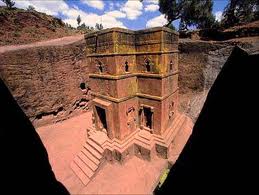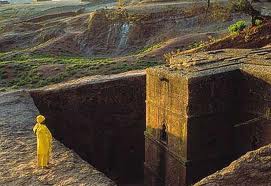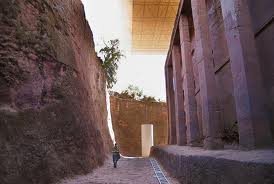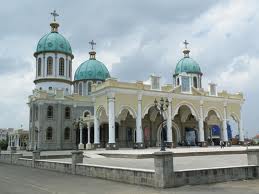
![]()
Index • |
Welcome • |
About
Us • |
21st Century • The Future |
World
Travel • Destinations |
Reviews • Books & Film |
Dreamscapes • Original Fiction |
Opinion
& Lifestyle • News Analysis |
Film
Space • Movies in depth |
Kid's
Books • Reviews & stories |
Dreamscapes Two • More Original Fiction |
Lifestyle 2011 • Politics & Living |
The International Writers Magazine: Ethiopia - Archives
• Elizabeth Schotten Merklinger
Nothing prepared me for the majesty of Ethiopia. I have always considered myself an intrepid traveler with quite a few unusual destinations under my belt from unknown Tibet to remote villages of Maharashtra. But never have I felt such a sense of otherness as here.
Ethiopia is the true forgotten land, lost in time and in its mountain vastness. There are no colonial bits and pieces around, no European baggage left as a landmark. Ethiopia alone, among African nations, was never colonized except for a very few years of Italian domination in the 1930's. It is simply a land unaffected by either East or West, a medieval relic forcibly juxtaposed unprepared and unwilling into the modern world.
For decades Ethiopia was virtually sealed off from the world. The northern highlands with their rich history of early Christianity ( Christianity appeared in Ethiopia at the time of the Apostles) were literally a mountain fastness isolated from neighbouring countries by vast stretches of the parched deserts we have come to associate with the ruinous famine of 1984-5. The remote rock-cut churches and other vestiges of the early Ethiopian Orthodox Church remained out of bounds as long as an anti-Western bureaucracy ruled. A further obstacle was a ravaging civil war which resulted after the Communist take-over in 1974. Only in the early '90's did a few fearless travel reports appear. But periodic political uncertainty stopped even this trickle of information . Fighting broke out again in May, 1998 between Ethiopia and Eritrea over 400 km of disputed fertile land in the north and to this day travel advisories caution prospective visitors about the advisability of a visit.
Ethiopia offers few modern conveniences, although the situation has improved since my last visit about ten years ago. Outside of Addis there may at times be no water and hot water only for an hour in the evening. Electricity is a new commodity in remote regions and in Lalibela, a World Heritage Site, was only introduced in the summer of 1998. Taxis may be scarce and it seemed to me that I could find more Ethipian taxi drivers in New York or London than in Addis. But, in contrast to the days I spent in Indian villages some decades ago brushing my teeth with Sivas Regal, there is a good and safe supply of bottled drinking water available everywhere, and there is excellent whiskey and beer. Nor do you need to sit endless hours on a rickety bus on non-existing roads (unless you wish to do so) over the most stunning mountain passes. You can now see the panorama comfortably. Ethiopian Airways has a remarkably efficient network of daily flights between the four historical sites most people come to see and the capital, Addis Ababa. Nor will you go hungry. But, if your taste for injera (that rather sour fermented spongy staple of the country) is not developed (and mine definitely is not), you may encounter some difficulty and be dependent on the overcooked English food available. A bright culinerary light is that splendid local beer, St.George, and the very pleasant Ethiopian red table wine.
The most exciting and obvious first choice of a visit to Ethiopia must be Lalibela, a remote highland village surrounded by stunning green mountains and the site of eleven rock-hewn medieval churches. Like the Taj Mahall and the Egyptian pyramids, it is one of the great spiritual sites of the world. Yet, the world is hardly aware of these churches, which elsewhere would be a major tourist attraction. Lalibela is an isolated village and on my first visit had only a tiny airterminal perched in the middle of fields planted with a local grain called tef . The generally used Fokker airplane was only able to land on weekends so as not to interrupt the farmhands as they tilled the fields during the working weekdays. Today DeHavilland DHC-8 Dash 8s have been substituted.
For over 50 years Lalibela has been on the UNESCO World Heritage site list but, despite this honour, it has scarcely been visited and remains hardly touched by the outside world. Perched 2630 m. above sea level amid wild craggy mountains and a rocky escarpment, it was formerly called Roha and was the capital of the Zagwe dynasty, which ruled Ethiopia from 10th to the mid-13th century. King Lalibela was the most famous of the Zagwe rulers and his birth and life (1181-1221) are shrouded in legend. Fearing his jealous half-brother who tried to poison him, he supposedly fled to Jerusalem and when in 1187 the city was conquered by Muslim invaders, Lalibela declared Roha to be a new Jerusalem. Another legend states that he was taken in trance to heaven and shown a complex of churches and then asked to reproduce what he had seen when he returned to earth, What is a fact, however, is that Lalibela assembled an army and builders and artists during his life-time to reconstruct the churches he had seen.
The wonder of these churches is that they were chiseled out of the red-hued volcanic rock at all and that they are still used for worship today. For 800 years the churches have been active Christian shrines and the scene has remained virtually unchanged. These extradordinary living monuments still serve the Ethiopian peasants, who, draped in their soiled shawls pray at the early morning services before starting to work in the fields.
The two clusters of Lalibela churches are separated by the Jordan River, The eastern seven and the western five churches are within striking distance of each other and are connected by a series of tunnels and passages. Bet Giorgis (St.George) is situated between the two groups. Each church has a different design but all have three entrances and a domed sanctuary and all are surrounded by trenches and courtyards. Some churches are carved out of the solid rock in the shape of a symmetrical cross like Bet Giorgis, which looms 11 m out of a deep trench, its roof level with the surrounding ground.
The most impressive churches are monoliths, standing free from the surrounding rock. The biggest of these, Bet Medhane Alem, the largest monolithic rock-hewn church in the world is over 11.5 m in height. Colourful religious paintings often depict the bloody treatment infidels received. Old Bibles made of goat-skins are handwritten and lavishly illustrated with religious paintings made by the monks.
To best experience the Ethiopian Orthodox Church, visit Lalibela during Ethiopian Christmas (Jan.7) or Epiphany (Jan.19), to see the most elaborate ceremonies, when the priests don their ornate white robes and turbans. But you can get a glimmer of the meaning of the church in the lives of peasants at every service, whether on a Sunday morning or one of the many saints days which dot the Ethiopian calendar. On Nov. 2, St.George's Day in the Ethiopian Orthodox Church, the courtyard is already full at 6:30 am. The streets are lined with people, women wearing the ubiquitious shammas on one side, the men on the other. In the courtyard the sexes are also segregated, women worshippers assembled near the women's door, men at the opposite side. Flying between these two rows are various shapes and sizes of beggars doing a lively business. The crowd is submissive, listening to the voice over the microphone. Occasionally, there is a communal bellow which rocks the entire assemblage.
No matter which legend or historian you may chose to believe, the history of Lalibela and the its eleven fabulous churches which mark the conversion of King Lalibela to Christianity remains a mystery. Carved from the top down, some hidden in deep trenches, others standing in open caves, the churches are connected by thin passageways, crypts, galleries and grottos. They were not built of rock, plaster or any other material but simply carved from the rock. And one has to ask oneself whether these monuments were in fact, as has been suggested, completed with the help of angels carrying masonry tools ? For if ever I believed in divine intervention, it is here in Lalibela.
© Elizabeth Schotten Merklinger - March 2012
More travel
*Elizabeth passed away in September 2020 and is much missed by her family and friends
Ethiopian airlines: www.ethiopianairlines.com; 020 8987 7000
The British Embassy website provides further information on travelling in Ethiopia, including a list of travel companies operating in Ethiopia.





